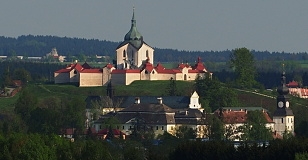Countryside location of the church
With respect to the importance attached to the church, and the activities assumed to be performed there, it was necessary to carefully choose the location where the church was to be built. In addition to meeting space requirements, the selected locality was surely expected to magnify the impression from unusual architectural shapes. The hillock located to the east of the monastery where the pilgrimage church was to be built, was originally covered with a dense forest. That was why it was called "Černý les" ("Black Forest"). The trees were cut down in connection with the building and the hillock was called "Zelená hora" ("Green Hill"), as a reference to the mother monastery of the religious house in Žďár and a place where John of Nepomuk had been born. The building has become a dominant point of the whole area due to its location on the top of the cut-over hillock.
It seems though that the ideal condition did not last long and after the church was closed, the free space around the church started to be used intensively. According to archive documents, Zelená hora had been partially covered with forest for a few years in 1839 (the north slope and part of the south slope), whereas the composition and quality of the trees were low. The remaining parts were covered, at many places, with bushes whose seeds had been spread there through air; they were used as cattle pastures. The owner of the manor, František Josef Prince Dietrichštejn, wanted to forest all of the areas. František Turinský, the then manager of the highest authority, did not recommended to do so regarding the low quality of the existing trees and the danger that the trees might be regularly destroyed by pilgrims. According to his opinion, it was most suitable to establish an English park but the Prince refused it because of huge financial costs. More modest adjustments approved by the Prince finally resulted in covering the whole area with forest in the 1840s though a wooden dancing room was established there to provide space for cultural enjoyment of the people for whom Zelená hora represented a tourist destination and a place to rest. The area remained forested until the beginning of the 21st century when the trees were cut again to revitalize the whole area. Thus today visitors have a chance to see the church in the same way as the locals and pilgrims saw it at the time of its greatest glory.
As we shall see in the following chapters, a place suitable in terms of convenience of the building in the country is not suitable in terms of the effect of climatic influences on the building, especially since the local country is among the less hospital ones. Used materials grow old and wear off quickly owing to the relative exposure of the area, which results in the need to maintain the monument much more often.

 Back to top
Back to top Search
Search